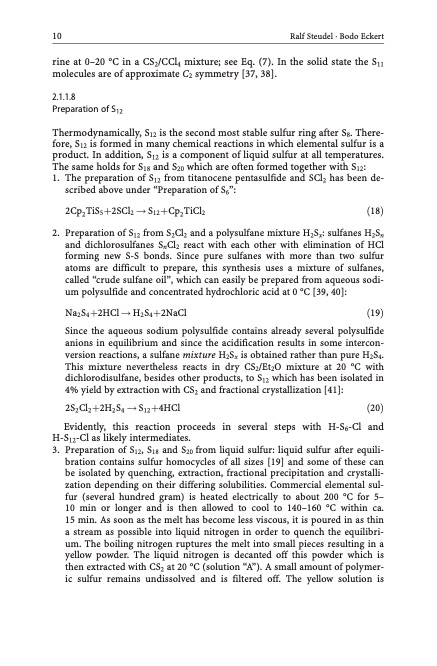
PDF Publication Title:
Text from PDF Page: 020
10 Ralf Steudel · Bodo Eckert rine at 0–20 C in a CS2/CCl4 mixture; see Eq. (7). In the solid state the S11 molecules are of approximate C2 symmetry [37, 38]. 2.1.1.8 Preparation of S12 Thermodynamically, S12 is the second most stable sulfur ring after S8. There- fore, S12 is formed in many chemical reactions in which elemental sulfur is a product. In addition, S12 is a component of liquid sulfur at all temperatures. The same holds for S18 and S20 which are often formed together with S12: 1. The preparation of S12 from titanocene pentasulfide and SCl2 has been de- scribed above under “Preparation of S6”: 2Cp2TiS5þ2SCl2 ! S12þCp2TiCl2 ð18Þ 2. Preparation of S12 from S2Cl2 and a polysulfane mixture H2Sx: sulfanes H2Sn and dichlorosulfanes SnCl2 react with each other with elimination of HCl forming new S-S bonds. Since pure sulfanes with more than two sulfur atoms are difficult to prepare, this synthesis uses a mixture of sulfanes, called “crude sulfane oil”, which can easily be prepared from aqueous sodi- um polysulfide and concentrated hydrochloric acid at 0 C [39, 40]: Na2S4þ2HCl ! H2S4þ2NaCl ð19Þ Since the aqueous sodium polysulfide contains already several polysulfide anions in equilibrium and since the acidification results in some intercon- version reactions, a sulfane mixture H2Sx is obtained rather than pure H2S4. This mixture nevertheless reacts in dry CS2/Et2O mixture at 20 C with dichlorodisulfane, besides other products, to S12 which has been isolated in 4% yield by extraction with CS2 and fractional crystallization [41]: 2S2Cl2þ2H2S4 ! S12þ4HCl ð20Þ Evidently, this reaction proceeds in several steps with H-S6-Cl and H-S12-Cl as likely intermediates. 3. Preparation of S12, S18 and S20 from liquid sulfur: liquid sulfur after equili- bration contains sulfur homocycles of all sizes [19] and some of these can be isolated by quenching, extraction, fractional precipitation and crystalli- zation depending on their differing solubilities. Commercial elemental sul- fur (several hundred gram) is heated electrically to about 200 C for 5– 10 min or longer and is then allowed to cool to 140–160 C within ca. 15 min. As soon as the melt has become less viscous, it is poured in as thin a stream as possible into liquid nitrogen in order to quench the equilibri- um. The boiling nitrogen ruptures the melt into small pieces resulting in a yellow powder. The liquid nitrogen is decanted off this powder which is then extracted with CS2 at 20 C (solution “A”). A small amount of polymer- ic sulfur remains undissolved and is filtered off. The yellow solution isPDF Image | Topics in Current Chemistry

PDF Search Title:
Topics in Current ChemistryOriginal File Name Searched:
Elemental-Sulfur-und-Sulfur-Rich-Compounds-I.pdfDIY PDF Search: Google It | Yahoo | Bing
Sulfur Deposition on Carbon Nanofibers using Supercritical CO2 Sulfur Deposition on Carbon Nanofibers using Supercritical CO2. Gamma sulfur also known as mother of pearl sulfur and nacreous sulfur... More Info
CO2 Organic Rankine Cycle Experimenter Platform The supercritical CO2 phase change system is both a heat pump and organic rankine cycle which can be used for those purposes and as a supercritical extractor for advanced subcritical and supercritical extraction technology. Uses include producing nanoparticles, precious metal CO2 extraction, lithium battery recycling, and other applications... More Info
| CONTACT TEL: 608-238-6001 Email: greg@infinityturbine.com | RSS | AMP |